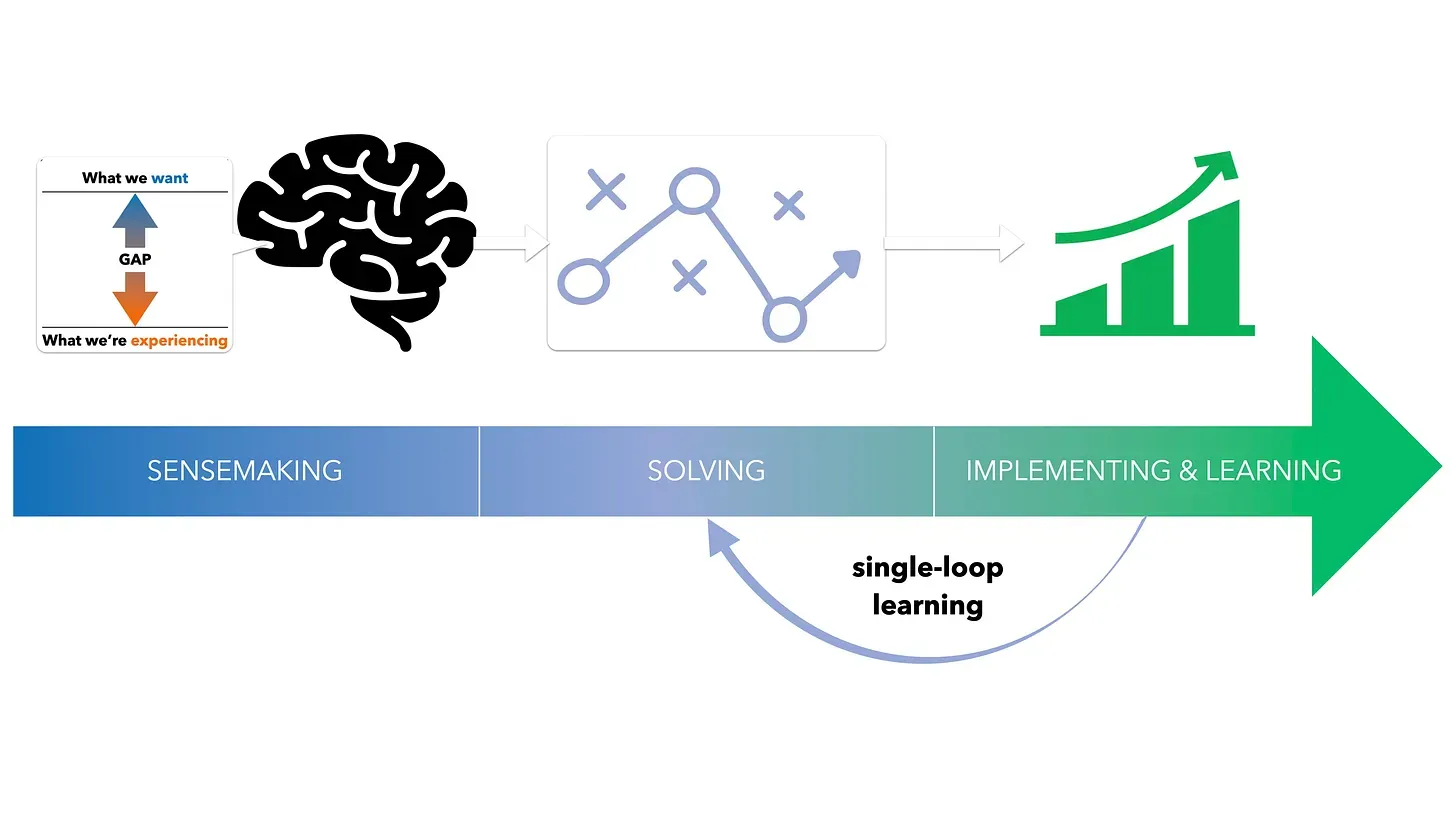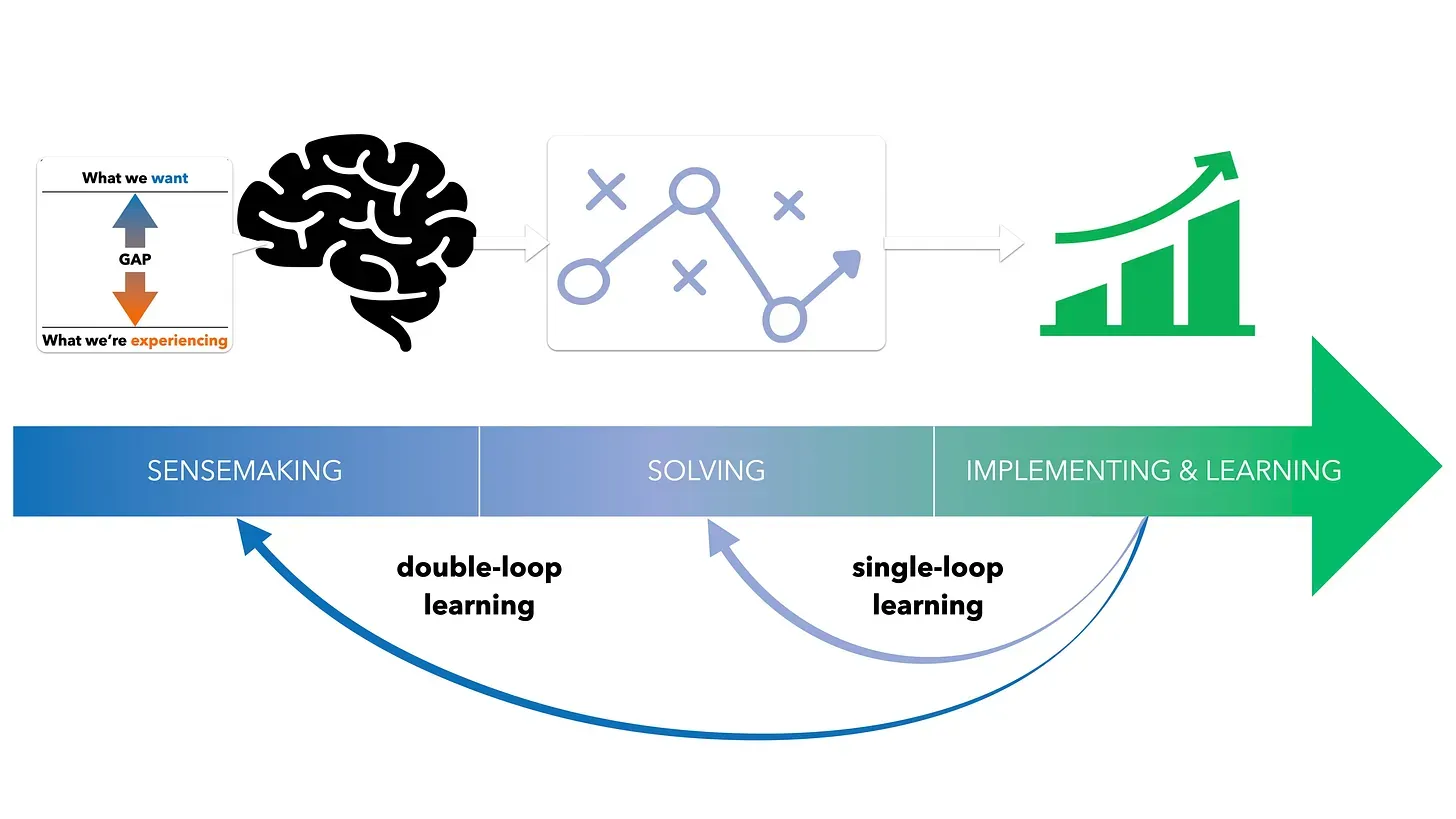🎯 SysQ Mindset

Mind
mindset Test
MINDSET
Performance Framing Graph (PFG)
A trend over time graph — or reference behavior pattern — of the system behavior(s) you want to understand and improve by applying SysQ.
About
Performance Framing Graphs are powerful visual tools that map the interests, concerns, and performance metrics of diverse stakeholder groups within a system. These graphs reveal interconnections among different perspectives, expanding everyone's field of vision beyond their immediate concerns. By visually representing each stakeholder's key metrics over time, Performance Framing Graphs (PFGs) can:
-
facilitate cross-boundary collaboration
-
highlight potential tensions and synergies
-
support the development of more inclusive strategies
PFGs are particularly valuable in addressing complex adaptive challenges that span organizational boundaries because they translate diverse perspectives into actionable insights, balanced scorecards, and comprehensive performance indicators that reflect the whole system rather than isolated parts.

Case Studies
Private Sector | Production and Order Fulfillment for a Multinational Engine Company
A cross-siloed management team at an engine production company was assigned the task of improving production. The concerning issue was that average time between receiving an order and fulfilling it had been steadily climbing (with seasonality) over the past few years.
Highlights
Lorem ipsum dolor sit amet, consectetur adipiscing elit, sed do eiusmod tempor incididunt ut labore et dolore magna aliqua. Ut enim ad minim veniam, quis nostrud exercitation ullamco laboris nisi ut aliquip ex ea commodo consequat. Duis aute irure dolor in reprehenderit in voluptate velit esse cillum dolore eu fugiat nulla pariatur. Excepteur sint occaecat cupidatat non proident, sunt in culpa qui officia deserunt mollit anim id est laborum.
Lorem ipsum dolor sit amet, consectetur adipiscing elit, sed do eiusmod tempor incididunt ut labore et dolore magna aliqua. Ut enim ad minim veniam, quis nostrud exercitation ullamco laboris nisi ut aliquip ex ea commodo consequat. Duis aute irure dolor in reprehenderit in voluptate velit esse cillum dolore eu fugiat nulla pariatur. Excepteur sint occaecat cupidatat non proident, sunt in culpa qui officia deserunt mollit anim id est laborum.

Public Sector | Example of Public Sector
Lorem ipsum dolor sit amet, consectetur adipiscing elit, sed do eiusmod tempor incididunt ut labore et dolore magna aliqua. Ut enim ad minim veniam, quis nostrud exercitation ullamco laboris nisi ut aliquip ex ea commodo consequat. Duis aute irure dolor in reprehenderit in voluptate velit esse cillum dolore eu fugiat nulla pariatur. Excepteur sint occaecat cupidatat non proident, sunt in culpa qui officia deserunt mollit anim id est laborum.
Highlights
Lorem ipsum dolor sit amet, consectetur adipiscing elit, sed do eiusmod tempor incididunt ut labore et dolore magna aliqua. Ut enim ad minim veniam, quis nostrud exercitation ullamco laboris nisi ut aliquip ex ea commodo consequat. Duis aute irure dolor in reprehenderit in voluptate velit esse cillum dolore eu fugiat nulla pariatur. Excepteur sint occaecat cupidatat non proident, sunt in culpa qui officia deserunt mollit anim id est laborum.
Lorem ipsum dolor sit amet, consectetur adipiscing elit, sed do eiusmod tempor incididunt ut labore et dolore magna aliqua. Ut enim ad minim veniam, quis nostrud exercitation ullamco laboris nisi ut aliquip ex ea commodo consequat. Duis aute irure dolor in reprehenderit in voluptate velit esse cillum dolore eu fugiat nulla pariatur. Excepteur sint occaecat cupidatat non proident, sunt in culpa qui officia deserunt mollit anim id est laborum.

Value
Describe the value of using the mindset attribute
-
Lorem ipsum dolor sit amet, consectetur adipiscing elit, sed do eiusmod tempor incididunt ut labore et dolore magna aliqua. Ut enim ad minim veniam, quis nostrud exercitation ullamco laboris nisi ut aliquip ex ea commodo consequat. Duis aute irure dolor in reprehenderit in voluptate velit esse cillum dolore eu fugiat nulla pariatur. Excepteur sint occaecat cupidatat non proident, sunt in culpa qui officia deserunt mollit anim id est laborum.
-
Lorem ipsum dolor sit amet, consectetur adipiscing elit, sed do eiusmod tempor incididunt ut labore et dolore magna aliqua. Ut enim ad minim veniam, quis nostrud exercitation ullamco laboris nisi ut aliquip ex ea commodo consequat. Duis aute irure dolor in reprehenderit in voluptate velit esse cillum dolore eu fugiat nulla pariatur. Excepteur sint occaecat cupidatat non proident, sunt in culpa qui officia deserunt mollit anim id est laborum.
-
Lorem ipsum dolor sit amet, consectetur adipiscing elit, sed do eiusmod tempor incididunt ut labore et dolore magna aliqua. Ut enim ad minim veniam, quis nostrud exercitation ullamco laboris nisi ut aliquip ex ea commodo consequat. Duis aute irure dolor in reprehenderit in voluptate velit esse cillum dolore eu fugiat nulla pariatur. Excepteur sint occaecat cupidatat non proident, sunt in culpa qui officia deserunt mollit anim id est laborum.
How to Build
Instructions for the Individual
Follow the steps below or download the following link
- Step Name
Lorem ipsum dolor sit amet, consectetur adipiscing elit, sed do eiusmod tempor incididunt ut labore et dolore magna aliqua. Ut enim ad minim veniam, quis nostrud exercitation ullamco laboris nisi ut aliquip ex ea commodo consequat. Duis aute irure dolor in reprehenderit in voluptate velit esse cillum dolore eu fugiat nulla pariatur. Excepteur sint occaecat cupidatat non proident, sunt in culpa qui officia deserunt mollit anim id est laborum.
-
Lorem ipsum dolor sit amet, consectetur adipiscing elit, sed do eiusmod tempor incididunt ut labore et dolore magna aliqua. Ut enim ad minim veniam, quis nostrud exercitation ullamco laboris nisi ut aliquip ex ea commodo consequat. Duis aute irure dolor in reprehenderit in voluptate velit esse cillum dolore eu fugiat nulla pariatur. Excepteur sint occaecat cupidatat non proident, sunt in culpa qui officia deserunt mollit anim id est laborum.
-
Lorem ipsum dolor sit amet, consectetur adipiscing elit, sed do eiusmod tempor incididunt ut labore et dolore magna aliqua. Ut enim ad minim veniam, quis nostrud exercitation ullamco laboris nisi ut aliquip ex ea commodo consequat. Duis aute irure dolor in reprehenderit in voluptate velit esse cillum dolore eu fugiat nulla pariatur. Excepteur sint occaecat cupidatat non proident, sunt in culpa qui officia deserunt mollit anim id est laborum.
-
Lorem ipsum dolor sit amet, consectetur adipiscing elit, sed do eiusmod tempor incididunt ut labore et dolore magna aliqua. Ut enim ad minim veniam, quis nostrud exercitation ullamco laboris nisi ut aliquip ex ea commodo consequat. Duis aute irure dolor in reprehenderit in voluptate velit esse cillum dolore eu fugiat nulla pariatur. Excepteur sint occaecat cupidatat non proident, sunt in culpa qui officia deserunt mollit anim id est laborum.
- Step Name
Lorem ipsum dolor sit amet, consectetur adipiscing elit, sed do eiusmod tempor incididunt ut labore et dolore magna aliqua. Ut enim ad minim veniam, quis nostrud exercitation ullamco laboris nisi ut aliquip ex ea commodo consequat. Duis aute irure dolor in reprehenderit in voluptate velit esse cillum dolore eu fugiat nulla pariatur. Excepteur sint occaecat cupidatat non proident, sunt in culpa qui officia deserunt mollit anim id est laborum.
-
Lorem ipsum dolor sit amet, consectetur adipiscing elit, sed do eiusmod tempor incididunt ut labore et dolore magna aliqua. Ut enim ad minim veniam, quis nostrud exercitation ullamco laboris nisi ut aliquip ex ea commodo consequat. Duis aute irure dolor in reprehenderit in voluptate velit esse cillum dolore eu fugiat nulla pariatur. Excepteur sint occaecat cupidatat non proident, sunt in culpa qui officia deserunt mollit anim id est laborum.
-
Lorem ipsum dolor sit amet, consectetur adipiscing elit, sed do eiusmod tempor incididunt ut labore et dolore magna aliqua. Ut enim ad minim veniam, quis nostrud exercitation ullamco laboris nisi ut aliquip ex ea commodo consequat. Duis aute irure dolor in reprehenderit in voluptate velit esse cillum dolore eu fugiat nulla pariatur. Excepteur sint occaecat cupidatat non proident, sunt in culpa qui officia deserunt mollit anim id est laborum.
-
Lorem ipsum dolor sit amet, consectetur adipiscing elit, sed do eiusmod tempor incididunt ut labore et dolore magna aliqua. Ut enim ad minim veniam, quis nostrud exercitation ullamco laboris nisi ut aliquip ex ea commodo consequat. Duis aute irure dolor in reprehenderit in voluptate velit esse cillum dolore eu fugiat nulla pariatur. Excepteur sint occaecat cupidatat non proident, sunt in culpa qui officia deserunt mollit anim id est laborum.
Instructions for Teams
Follow the steps below or download the following link
- Step Name
Lorem ipsum dolor sit amet, consectetur adipiscing elit, sed do eiusmod tempor incididunt ut labore et dolore magna aliqua. Ut enim ad minim veniam, quis nostrud exercitation ullamco laboris nisi ut aliquip ex ea commodo consequat. Duis aute irure dolor in reprehenderit in voluptate velit esse cillum dolore eu fugiat nulla pariatur. Excepteur sint occaecat cupidatat non proident, sunt in culpa qui officia deserunt mollit anim id est laborum.
-
Lorem ipsum dolor sit amet, consectetur adipiscing elit, sed do eiusmod tempor incididunt ut labore et dolore magna aliqua. Ut enim ad minim veniam, quis nostrud exercitation ullamco laboris nisi ut aliquip ex ea commodo
consequat. Duis aute irure dolor in reprehenderit in voluptate velit esse cillum dolore eu fugiat nulla pariatur. Excepteur sint occaecat cupidatat non proident, sunt in culpa qui officia deserunt mollit anim id est laborum. -
Lorem ipsum dolor sit amet, consectetur adipiscing elit, sed do eiusmod tempor incididunt ut labore et dolore magna aliqua. Ut enim ad minim veniam, quis nostrud exercitation ullamco laboris nisi ut aliquip ex ea commodo
consequat. Duis aute irure dolor in reprehenderit in voluptate velit esse cillum dolore eu fugiat nulla pariatur. Excepteur sint occaecat cupidatat non proident, sunt in culpa qui officia deserunt mollit anim id est laborum. -
Lorem ipsum dolor sit amet, consectetur adipiscing elit, sed do eiusmod tempor incididunt ut labore et dolore magna aliqua. Ut enim ad minim veniam, quis nostrud exercitation ullamco laboris nisi ut aliquip ex ea commodo
consequat. Duis aute irure dolor in reprehenderit in voluptate velit esse cillum dolore eu fugiat nulla pariatur. Excepteur sint occaecat cupidatat non proident, sunt in culpa qui officia deserunt mollit anim id est laborum.
- Step Name
Lorem ipsum dolor sit amet, consectetur adipiscing elit, sed do eiusmod tempor incididunt ut labore et dolore magna aliqua. Ut enim ad minim veniam, quis nostrud exercitation ullamco laboris nisi ut aliquip ex ea commodo consequat. Duis aute irure dolor in reprehenderit in voluptate velit esse cillum dolore eu fugiat nulla pariatur. Excepteur sint occaecat cupidatat non proident, sunt in culpa qui officia deserunt mollit anim id est laborum.
-
Lorem ipsum dolor sit amet, consectetur adipiscing elit, sed do eiusmod tempor incididunt ut labore et dolore magna aliqua. Ut enim ad minim veniam, quis nostrud exercitation ullamco laboris nisi ut aliquip ex ea commodo
consequat. Duis aute irure dolor in reprehenderit in voluptate velit esse cillum dolore eu fugiat nulla pariatur. Excepteur sint occaecat cupidatat non proident, sunt in culpa qui officia deserunt mollit anim id est laborum. -
Lorem ipsum dolor sit amet, consectetur adipiscing elit, sed do eiusmod tempor incididunt ut labore et dolore magna aliqua. Ut enim ad minim veniam, quis nostrud exercitation ullamco laboris nisi ut aliquip ex ea commodo
consequat. Duis aute irure dolor in reprehenderit in voluptate velit esse cillum dolore eu fugiat nulla pariatur. Excepteur sint occaecat cupidatat non proident, sunt in culpa qui officia deserunt mollit anim id est laborum. -
Lorem ipsum dolor sit amet, consectetur adipiscing elit, sed do eiusmod tempor incididunt ut labore et dolore magna aliqua. Ut enim ad minim veniam, quis nostrud exercitation ullamco laboris nisi ut aliquip ex ea commodo
consequat. Duis aute irure dolor in reprehenderit in voluptate velit esse cillum dolore eu fugiat nulla pariatur. Excepteur sint occaecat cupidatat non proident, sunt in culpa qui officia deserunt mollit anim id est laborum.
Connections to Other SysQ Components
Describe the value of using the mindset attribute
- SysQ Mindset
Lorem ipsum dolor sit amet, consectetur adipiscing elit, sed do eiusmod tempor incididunt ut labore et dolore magna aliqua. Ut enim ad minim veniam, quis nostrud exercitation ullamco laboris nisi ut aliquip ex ea commodo consequat. Duis aute irure dolor in reprehenderit in voluptate velit esse cillum dolore eu fugiat nulla pariatur. Excepteur sint occaecat cupidatat non proident, sunt in culpa qui officia deserunt mollit anim id est laborum. Learn more
- SysQ Process
Lorem ipsum dolor sit amet, consectetur adipiscing elit, sed do eiusmod tempor incididunt ut labore et dolore magna aliqua. Ut enim ad minim veniam, quis nostrud exercitation ullamco laboris nisi ut aliquip ex ea commodo consequat. Duis aute irure dolor in reprehenderit in voluptate velit esse cillum dolore eu fugiat nulla pariatur. Excepteur sint occaecat cupidatat non proident, sunt in culpa qui officia deserunt mollit anim id est laborum. Learn more
- SysQ Thinking
Description. Lorem ipsum dolor sit amet, consectetur adipiscing elit, sed do eiusmod tempor incididunt ut labore et dolore magna aliqua. Ut enim ad minim veniam, quis nostrud exercitation ullamco laboris nisi ut aliquip ex ea commodo consequat. Duis aute irure dolor in reprehenderit in voluptate velit esse cillum dolore eu fugiat nulla pariatur. Excepteur sint occaecat cupidatat non proident, sunt in culpa qui officia deserunt mollit anim id est laborum.
This tool is essential for these steps:
- Step Name
Lorem ipsum dolor sit amet, consectetur adipiscing elit, sed do eiusmod tempor incididunt ut labore et dolore magna aliqua. Ut enim ad minim veniam, quis nostrud exercitation ullamco laboris nisi ut aliquip ex ea commodo consequat. Duis aute irure dolor in reprehenderit in voluptate velit esse cillum dolore eu fugiat nulla pariatur. Excepteur sint occaecat cupidatat non proident, sunt in culpa qui officia deserunt mollit anim id est laborum.Learn more
- Step Name
Lorem ipsum dolor sit amet, consectetur adipiscing elit, sed do eiusmod tempor incididunt ut labore et dolore magna aliqua. Ut enim ad minim veniam, quis nostrud exercitation ullamco laboris nisi ut aliquip ex ea commodo consequat. Duis aute irure dolor in reprehenderit in voluptate velit esse cillum dolore eu fugiat nulla pariatur. Excepteur sint occaecat cupidatat non proident, sunt in culpa qui officia deserunt mollit anim id est laborum. Learn more
- Step Name
Lorem ipsum dolor sit amet, consectetur adipiscing elit, sed do eiusmod tempor incididunt ut labore et dolore magna aliqua. Ut enim ad minim veniam, quis nostrud exercitation ullamco laboris nisi ut aliquip ex ea commodo consequat. Duis aute irure dolor in reprehenderit in voluptate velit esse cillum dolore eu fugiat nulla pariatur. Excepteur sint occaecat cupidatat non proident, sunt in culpa qui officia deserunt mollit anim id est laborum. Learn more
Conclusion
Lorem ipsum dolor sit amet, consectetur adipiscing elit, sed do eiusmod tempor incididunt ut labore et dolore magna aliqua. Ut enim ad minim veniam, quis nostrud exercitation ullamco laboris nisi ut aliquip ex ea commodo consequat. Duis aute irure dolor in reprehenderit in voluptate velit esse cillum dolore eu fugiat nulla pariatur. Excepteur sint occaecat cupidatat non proident, sunt in culpa qui officia deserunt mollit anim id est laborum.
Lorem ipsum dolor sit amet, consectetur adipiscing elit, sed do eiusmod tempor incididunt ut labore et dolore magna aliqua. Ut enim ad minim veniam, quis nostrud exercitation ullamco laboris nisi ut aliquip ex ea commodo consequat. Duis aute irure dolor in reprehenderit in voluptate velit esse cillum dolore eu fugiat nulla pariatur. Excepteur sint occaecat cupidatat non proident, sunt in culpa qui officia deserunt mollit anim id est laborum.
Additional Resources
Books
Book title as link | Description
Articles
Article title as link | Description
Online Resources
Resource title as link | Description

Mind
Breaking Free From the Hamster Wheel: The Power of Double-Loop Learning
MINDSET
Attribute of Mindset
Lorem ipsum dolor sit amet, consectetur adipiscing elit, sed do eiusmod tempor incididunt ut labore et dolore magna aliqua
About
Overview of the attribute. Lorem ipsum dolor sit amet, consectetur adipiscing elit, sed do eiusmod tempor incididunt ut labore et dolore magna aliqua. Ut enim ad minim veniam, quis nostrud exercitation ullamco laboris nisi ut aliquip ex ea commodo consequat. Duis aute irure dolor in reprehenderit in voluptate velit esse cillum dolore eu fugiat nulla pariatur. Excepteur sint occaecat cupidatat non proident, sunt in culpa qui officia deserunt mollit anim id est laborum.
“The illiterate of the twenty-first century will not be those who cannot read and write, but those who cannot learn, unlearn, and relearn.” — Alvin Toffler The Problem with Our Mental Models
Have you ever felt like your organization is running faster and faster just to stay in the same place? Like Alice in Wonderland, many leaders find themselves stuck in what I call the "organizational hamster wheel" - expending enormous energy without making real progress. The root cause often lies in our mental models - the stories and assumptions we use to make sense of the world.
The Limits of Single-Loop Learning
Most organizations default to what Chris Argyris calls single-loop learning - we observe an outcome we don't like, make an adjustment based on our existing mental models, and hope for better results. Consider these cautionary examples:
Wells Fargo tried to improve performance by incentivizing employees to open more accounts. This led to widespread fraud as employees opened accounts without customer knowledge.
Humanitarian organizations attempted to combat malnutrition in Peru by providing food directly to families. They didn't anticipate that families would give the food primarily to working males, leaving children still malnourished.
A claims processing department faced high workload and responded by aggressive hiring. This actually worsened their problems as training demands increased stress on experienced staff, leading to more turnover.
In each case, organizations applied solutions that made intuitive sense based on their existing mental models. But those models were fatally flawed.
The Anatomy of Problem-Solving
To understand why organizations fall into these traps, let's examine the three distinct phases of problem-solving.
Phase 1: Sense-making
We begin by identifying a gap between our current reality and our vision of an ideal future state. Think of it as the difference between "what is" and "what could be." This gap forms the frame of our problem. We then access our mental models - our theories about how the world works - to make sense of this gap and its causes.

Phase 2: Solving
Using these mental models as our guide, we develop solutions. Like a receipt printing from a checkout machine, our mental models process the problem and output what we believe to be the best plan or strategy. While this might seem oversimplified, it evocatively represents how we move from understanding to strategy and decisions.
Phase 3: Implementing and Learning
Finally, we put our solution into action and observe the results. Sometimes everything works as planned. But often, we face unexpected outcomes or find the gap persists. At this critical juncture, we face a choice: do we just adjust oursolution, or do we question our underlying assumptions?
This is where many organizations get stuck. When faced with disappointing results, the natural tendency is to loop back to Phase 2 - tweaking the solution while using the same mental model.

Remember our claims processing department? When their initial hiring push didn't solve the problem, they simply decided to hire even more people, faster. This is classic single-loop learning - adjusting the solution without questioning the underlying assumptions that created the problem in the first place.
Understanding Double-Loop Learning
This is where double-loop learning is required. Instead of just adjusting our actions (the single loop), we examine and revise our fundamental assumptions about the problem (the second loop). We surface, explore, test, and improve our mental models.

The process works like this:
We identify a performance gap between our aspirations and reality Instead of jumping to solutions, we pause to examine our mental models We use tools like systems mapping to make our assumptions explicit We test and revise those assumptions based on evidence We develop new mental models that better reflect reality Only then do we design solutions based on these improved models
Moneyball: The Power of Double-Loop Learning
One of the clearest examples comes from baseball. Billy Beane and the Oakland A's revolutionized how baseball teams evaluate talent by questioning fundamental assumptions about what makes a valuable player. The conventional mental model focused on batting average and RBIs. By examining and revising these mental models, they discovered that on-base percentage and slugging percentage were better predictors of offensive success.
This wasn't just about trying a different metric - it was about fundamentally reconceptualizing how baseball talent evaluation worked. The results transformed the sport.
Building Better Mental Models Through Systems Thinking
Effective double-loop learning requires what's called "systemic intelligence" or SysQ - the ability to see and understand the driving characteristics of complex systems. This involves:
Making mental models explicit through visualization tools Understanding how different parts of the system interact Identifying high-leverage intervention points Testing assumptions through careful observation Learning continuously during implementation
Billy Beane — and his management staff — double-looped their mental models of what makes great baseball players. The claims department mentioned earlier eventually double-looped and stopped hiring to address staff shortage. And organizations working to address malnutrition in Perú also created a double-looped, collective mental model of why malnutrition persisted…and how to reduce it.
Moving from Theory to Practice
To apply double-loop learning in your organization, team, or coalition:
When facing persistent problems, pause to examine your mental models — step off the hamster wheel!Where possible, use tools like system mapping to make assumptions explicit Apply Conversational Capacity to engage multiple perspectives — challenge your mental models Test revised models with small experiments — use maps or simulation models if possible Create learning loops to enable continuous learning — leading indicators are especially valuable
Remember: the goal isn't just to solve today's problem, but to transform our understanding in ways that help us handle future challenges better. That's how organizations break free from the hamster wheel and achieve sustainable success.
Double-Loop Learning in Action: Two Success Stories
Transforming Huntsville into a Tech Hub
Huntsville, Alabama faced a critical challenge: despite attracting young tech talent for internships and entry-level positions, they couldn't retain them. The city's initial mental model assumed this was primarily a compensation issue. However, through a rigorous ecosystem mapping process, they discovered something surprising: their strategy of importing seasoned STEM professionals was actually undermining their ability to retain young talent.
The mapping process revealed that young professionals weren't leaving primarily because of money - they were leaving because they were bored. This insight led to a fundamental shift in their mental model about what makes a city attractive to tech talent. Instead of just focusing on traditional economic development, they realized they needed to invest in what they called the "soft stuff":
Creating vibrant arts and culture scenes Developing outdoor shopping areas with restaurants Establishing entertainment venues like minor league baseball Building community gathering spaces
By questioning and revising their mental models about talent retention, Huntsville transformed itself into one of America's most attractive tech communities. This wasn't just a change in tactics - it represented a fundamental shift in how they thought about economic development.
Reimagining Claims Processing
A Fortune 100 financial services company provides another powerful example of double-loop learning. Their claims department faced a perfect storm: high turnover, increasing workload, stressed employees, and declining customer satisfaction. Their initial mental model suggested a straightforward solution: hire more people faster.
However, through a series of facilitated mapping sessions, they discovered that their assumptions about the problem were fundamentally flawed. The mapping process revealed:
Faster hiring actually increased stress on experienced staff Training burdens were overwhelming mentors Emotional intelligence was more critical than technical skills Staff well-being directly impacted customer satisfaction
This new understanding led them to completely reimagine their approach. Instead of just accelerating hiring, they:
Developed emotional intelligence training programs Created formal mentoring structures with manageable ratios Implemented stress management initiatives Built workload management systems that balanced efficiency with employee wellbeing
The results were transformative: higher employee satisfaction, lower turnover, and better customer outcomes. But perhaps most importantly, they developed a new mental model about the relationship between employee development, workplace stress, and organizational performance.
The Learning Organization: Moving Beyond the Hamster Wheel
These success stories illustrate a crucial point: double-loop learning isn't just about solving problems - it's about transforming how organizations think about their challenges. In both cases, success came not from trying harder within existing mental models, but from fundamentally reconceptualizing the nature of their challenges. By seeing deeper…with greater rigor and clarity.
The ultimate benefit extends beyond solving individual problems. It creates what Peter Senge calls a "learning organization" - one that's constantly examining and improving its mental models and growing its systemic intelligence (SysQ).
In today's complex world, this capacity for deep learning might be the most important competitive advantage an organization can develop. Are you ready to question your mental models and engage in double-loop learning?
Case Studies
Private Sector | Example of Private Sector
Lorem ipsum dolor sit amet, consectetur adipiscing elit, sed do eiusmod tempor incididunt ut labore et dolore magna aliqua. Ut enim ad minim veniam, quis nostrud exercitation ullamco laboris nisi ut aliquip ex ea commodo consequat. Duis aute irure dolor in reprehenderit in voluptate velit esse cillum dolore eu fugiat nulla pariatur. Excepteur sint occaecat cupidatat non proident, sunt in culpa qui officia deserunt mollit anim id est laborum.
Highlights
Lorem ipsum dolor sit amet, consectetur adipiscing elit, sed do eiusmod tempor incididunt ut labore et dolore magna aliqua. Ut enim ad minim veniam, quis nostrud exercitation ullamco laboris nisi ut aliquip ex ea commodo consequat. Duis aute irure dolor in reprehenderit in voluptate velit esse cillum dolore eu fugiat nulla pariatur. Excepteur sint occaecat cupidatat non proident, sunt in culpa qui officia deserunt mollit anim id est laborum.
Lorem ipsum dolor sit amet, consectetur adipiscing elit, sed do eiusmod tempor incididunt ut labore et dolore magna aliqua. Ut enim ad minim veniam, quis nostrud exercitation ullamco laboris nisi ut aliquip ex ea commodo consequat. Duis aute irure dolor in reprehenderit in voluptate velit esse cillum dolore eu fugiat nulla pariatur. Excepteur sint occaecat cupidatat non proident, sunt in culpa qui officia deserunt mollit anim id est laborum.
Additional Resources
Books
Book title as link | Description
Articles
Article title as link | Description
Online Resources
Resource title as link | Description

Mind
🎯 Purpose? Seeing Structural Forces Generating Performance...and Finding Leverage
MINDSET
Attribute of Mindset
Lorem ipsum dolor sit amet, consectetur adipiscing elit, sed do eiusmod tempor incididunt ut labore et dolore magna aliqua
About
Overview of the attribute. Lorem ipsum dolor sit amet, consectetur adipiscing elit, sed do eiusmod tempor incididunt ut labore et dolore magna aliqua. Ut enim ad minim veniam, quis nostrud exercitation ullamco laboris nisi ut aliquip ex ea commodo consequat. Duis aute irure dolor in reprehenderit in voluptate velit esse cillum dolore eu fugiat nulla pariatur. Excepteur sint occaecat cupidatat non proident, sunt in culpa qui officia deserunt mollit anim id est laborum.
“The important thing in science is not so much to obtain new facts as to discover new ways of thinking about them.” —Sir William Bragg
The slinky principle: Transforming how we see and solve problems.
In today's rapidly evolving world, we face increasingly complex challenges - from organizational transformation to climate change, from healthcare reform to technological disruption. Yet our approach to solving these challenges often resembles watching a magic show: we see the effects but struggle to understand the underlying causes. We react to symptoms, implement quick fixes, and wonder why our solutions don't stick. There's a better way.
Systemic Intelligence (SysQ) offers a powerful lens for seeing and solving complex problems. Like a skilled magician who understands the mechanics behind illusions, those with high SysQ can peer beneath surface-level events to grasp the deeper structures driving behavior. This capability isn't just academic - it's the key to finding genuine leverage points for lasting change. Whether you're a business leader navigating market disruption, a policymaker addressing societal challenges, or an individual trying to create sustainable change, understanding the "magic" behind system behavior is your pathway to more effective action.
SysQ’s magic helps you find leverage — the ability to fundamentally transform the system you wish to improve. This requires understanding the mindset — or as I often think of it, the purpose or aim of systemic intelligence. The aim of SysQ is summarized in a a core tenet that is the magic phrase you’ll need to find the leverage you want.
To Find Leverage You Must First Understand the Structure Driving Behavior
EXAMPLE — SYSTEM 1
I’m going to administer an input to this system.
Answer the following question with the first idea coming to mind.
So gravity and removing the hand are necessary but insufficient to create the oscillating behavior.
What’s the cause of this behavior?
One important attribute of leverage is the ability to fundamentally improve ecosystem performance. Imagine that you want to significantly improve the oscillations — to dramatically dampen them — perhaps they are creating chaos in your organization.
If your mental model is that gravity is causing the oscillation, how much leverage do you have? None. You can’t change gravity. I imagine you can identify times in your work and personal lives where it feels like fighting gravity — something refuses to improve no matter hard you try.
If your mental model is that removing the hand is causing the oscillation, how much leverage do you have? Before you say some, let’s also say you don’t own the hand. Again you have no leverage. You can either become an Eeyore and proclaim nothing will change. Or you’ll be a victim and blame others. Either way, you’re stuck with a persisting problem.
However, if your mental model is that the system generates the behavior, you can modify the system so that when the hand is removed by someone else — and even though gravity exists — the behavior is fundamentally improved. You’ve found leverage.
Ascribing the cause of the behavior to the system — the structure of the slinky will
Watch this cotton candy eating contest.1
Whose mental model is the high-leverage one?
FOCUS ONLY ON THE STRUCTURE GENERATING PERFORMANCE
We often respond to problems using the same old thinking — applying outdated and inaccurate mental models — without once questioning: Do I know the structure of this ecosystem that’s responsible for this problem?
If we don’t develop sufficient systemic insight into how the ecosystem works we will be unable to achieve the performance goals we set. We will continue to be buffeted by the “slings and arrows of outrageous fortune”. The Focus is Only on the Structure Generating Performance
Disciplined application of SysQ means we focus only on the structure generating performance. People with high SysQ first filter out the essential from the mess — from the noisy barrage of data — to cogently establish what performance they wish to transform…what they wish to see unfold in the future. Then they assemble a mental model of the structure that can generate that performance.
They use a range of tools to pool perspectives into a collective mental model that understand this structure. You may have heard of systems archetypes, causal loop diagrams, stock and flow maps, and simulation models. Each of these tools has its place in developing a more rigorous “picture” of the structure. Sometimes a simple archetype or causal loop diagrams is sufficient; sometimes teams need to spend the time and resources to develop a computer simulation model. You’ll learn more about each of these tools in this substack — and can dive into ones you find most relevant to your current needs. Back to the aim of SysQ.
Having high SysQ means avoiding wasted time in trying to understand EVERYTHING about the ecosystem. Remember the slinky: all I need to know to improve performance is to focus on the structure. If I tried to understand the whole system I’d needlessly spend time analyzing the colors or the shape. Similarly, with the cotton candy system, although perhaps of great importance to the eater, the flavors or colors don’t contribute one iota to how the structure behaves. Yet many of my clients want to spend time analyzing interesting aspects of their ecosystem — even though those aspects are irrelevant. Studying them consumes precious time and resources…often leading to the dreaded analysis paralysis.
WE OFTEN FOCUS ON THE LOW LEVERAGE
Organizations often focus on low leverage interventions, investments, and policies. They will adjust price up or down. They’ll tweak a complex budget a few percentage points one way or another. They’ll replace one person in a leadership position with a different one — without changing how the rest of the organization around the individual works with them.
These low leverage interventions cannot fundamentally change behavior — changing the colors on the slinky would change its appearance, but it will still oscillate.
Our low leverage strategies overlook more transformational interventions: radically modifying rewards and incentives; changing the type of data generated — including who does…or doesn’t…have that information; and shifting fundamental paradigms — like competition vs cooperation.
SysQ helps identify those higher leverage interventions often overlooked when developing strategy. Remember, the basic tenet of SysQ — the underlying mindset — is:
To Find Leverage You Must First Understand the Structure Driving Behavior
Additional Resources
Books
Book title as link | Description
Articles
Article title as link | Description
Online Resources
Resource title as link | Description







